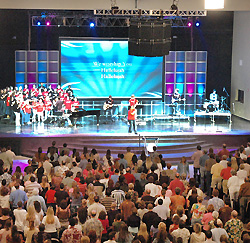
I suspect many a church member, pastor and board member read that blog post and ran into the sound booth yelling, “Here it is! Proof that it’s too loud. Never more than 75 dB [sic] again!”
This does about as much good at solving the volume problem as painting a green lobby blue does at placating those who don’t like anything but yellow.
The article was not all bad, however. In fact, aside from those three points, I think he is on balance. In fact, I agree with more than I disagree with.
I completely agree that spectral balance is key. He made the observation (from his free, RTA Lite app) that the overall sound was balanced and smooth.
I would argue that spectral balance is more important than actual SPL levels in determining what is acceptable to a congregation and what is not.
For example, even if we agreed that 75 dB (A- or C-weighted, it doesn’t matter for this illustration) SPL is the “perfect” volume, I could drive everyone out of the room by playing a 1KHz square wave at 75 dBA SPL. I could also put together a mix that sounds so offensive at 75 dB SPLA that people would still complain.
On the other hand, I’ve heard mixes that averaged well over 100 dB SPLA and not only did people not complain, they had their hands up and wanted more.
The key is getting the spectral balance right. Too many young engineers (and to be fair, some old ones) put way too much emphasis either on the extreme low end, or the top end. I’ve been to a couple of conferences lately where this was certainly true. At both, the low end was so over-emphasized that you could almost see those 8-foot long waves gobbling up everything else. It sounded terrible—the volume didn’t matter at all.
But in a well crafted mix, people want more. At least up to a point. But we’ll get back to that.
Like other things, content is king. He didn’t point this out as much in the article, but in subsequent comments, he pointed out that Disney has professional talent on stage and in the booth. So, the quality of the content in the mix was very high, and the mix itself was well done.
It was also being played through a well tuned Meyer Sound PA. And he intimated that there was the appropriate amount of dynamic range to the program. Because the average level was comfortable, loud portions of the show felt good.
If most of the congregation thinks it’s too loud, it’s too loud. I’ll probably take some flak for this one, but I believe it’s true. I can’t figure out why churches with a mostly older demographic hire young worship leaders “to attract the younger people” then get upset when the worship gets loud.
On the other hand, I can’t figure out why worship leaders and sound people go into older churches and try to “turn the tide,” crank it up to 11 and then wonder why people get mad and leave.
If you are standing in the sound booth looking out over the congregation and many of them have their hands over their ears, something is wrong. You need to figure out what it is. It may be a mix issue, the drums on stage may be too loud, or the music might be entirely wrong for the congregation. Or it may just be too loud.
Either way, you’re not doing yourself or anyone else any favors by quoting OSHA guidelines or Bible verses about loud worship.
Most of the time, the absolute volume is not the issue, but when something is wrong, we need to investigate it and fix it. We’ll tackle what I think the most common issues are next time.
Mike Sessler now works with Visioneering, where he helps churches improve their AVL systems, and encourages and trains the technical artists that run them. He has been involved in live production for over 25 years and is the author of the blog Church Tech Arts.
